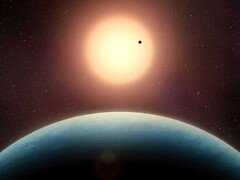Many discoveries are made every year in the night sky, and some are astonishing. Such is the case of this planet, which fascinates astronomers by its potential to harbor life due to its location.
After years of collecting data with precision instruments, a team from Montreal discovered a fifth planet in the L 98-59 system. This was no mean feat, as the star in this system, 35 light-years away, is barely visible in the night sky, making it very difficult to observe.
Since 2019, three planets have been discovered thanks to the TESS satellite, and a fourth has been spotted using the ESPRESSO spectrograph. Now, a fifth planet has been discovered using the radial velocity method, also known as Doppler spectroscopy.
This planet, named L 98-59 f, lies in the habitable zone of its star, a red dwarf, as is the case with Earth. And that’s not all: it receives as much energy from its star as we do from the Sun. In other words, it’s similar in that it’s not in a zone that’s too hot or too cold for its star.
What’s more, Charles Cadieux, researcher at the Trottier Institute for Research on Exoplanets (IREx), has this to say on the subject: “With a mass 2.8 times that of the Earth and a stable orbit of 23 days, L 98-59 f becomes an ideal target for atmospheric characterization”. But that’s not all, as this also shows that red dwarfs, although small, can harbor diverse and varied worlds: “It reinforces the idea that red dwarfs, despite their small size, can harbor fascinating, and potentially habitable, worlds”.
Of course, further studies will have to be carried out, as in the case of its atmosphere with the James Webb Space Telescope, to find out whether it harbors or could harbor life in the near future. However, this unique discovery allows us to move forward in the search for life in the universe by studying other places in the celestial vault, and perhaps one day this old mystery will be solved.
I’ve been working in the field of web writing for several years, and I’m passionate about keeping readers up to date with the latest news on astronomy, technology, the world of video games and other exciting subjects. In particular, I’ve had the opportunity to work on a number of websites, which has enabled me to cover a wide range of subjects. In my personal life, I’m passionate about a wide range of subjects, including astronomy, video games, history and science. I’m also drawn to psychology, which is a subject that deserves greater documentation and recognition.









